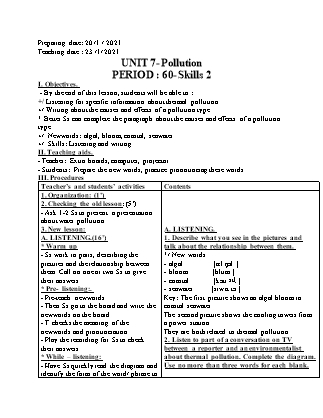Giáo án Tiếng Anh Lớp 8 - Unit 7: Pollution - Period 60: Skills 2 - Năm học 2020-2021

I. Objectives.
- By the end of this lesson, students will be able to :
+/ Listening for specific information about thermal pollution.
+/ Writing about the causes and effects of a pollution type.
* Better Ss can complete the paragraph about the causes and effects of a pollution type
+/ Newwords: algal, bloom, coastal, seawater
+/ Skills: Listening and writing
II. Teaching aids.
- Teacher: Extra boards, computer, projector
- Students: Prepare the new words, practice pronouncing these words
Bạn đang xem tài liệu "Giáo án Tiếng Anh Lớp 8 - Unit 7: Pollution - Period 60: Skills 2 - Năm học 2020-2021", để tải tài liệu gốc về máy bạn click vào nút DOWNLOAD ở trên
Preparing date: 20 /1 / 2021 Teaching date : 23 /1/ 2021 UNIT 7- Pollution PERIOD : 60- Skills 2 I. Objectives. - By the end of this lesson, students will be able to : +/ Listening for specific information about thermal pollution. +/ Writing about the causes and effects of a pollution type. * Better Ss can complete the paragraph about the causes and effects of a pollution type +/ Newwords: algal, bloom, coastal, seawater +/ Skills: Listening and writing II. Teaching aids. - Teacher: Extra boards, computer, projector - Students: Prepare the new words, practice pronouncing these words III. Procedures. Teacher’s and students’ activities Contents 1. Organization: (1’) 2. Checking the old lesson: (5’) - Ask 1-2 Ss to present a presentation about water pollution 3. New lesson: A. LISTENING.(16’) * Warm up - Ss work in pairs, describing the pictures and the relationship between them. Call on one or two Ss to give their answers. . * Pre- listening:. - Pre-teach newwords. - Then Ss go to the board and write the newwords on the board. - T checks the meaning of the newwords and pronunciation. - Play the recording for Ss to check their answers. * While – listening: - Have Ss quickly read the diagram and identify the form of the word/ phrase to be filled in each blank. - Ask Ss to give the answers before listening. - T plays the recording twice. - Ss listen and check their answers. - T and the whole class check together * Post- listening: - Ask some Ss to retell the thermal pollution - T gives feedback B. WRITING : (20’) * Pre- writing: - Ss work in pairs and decide which pollution type in their area they are going to discuss. - Have Ss take notes of the causes and effects. Move around to offer help as pairs discuss their ideas. * While- writing: - T asks Ss to work in pairs, one writes about the causes and the other writes about the effects based on their notes from 3. - Remind Ss to use markers like firstly, secondly, finaly to navigate through their points. - T calls 2 groups write their writings on the board. - T checks with the whole class. * Post- writing: - Have Ss share their work with each other and combine it to make a complete article. - Tell them that they should add one or two sentences at the beginning to introduce the topic and other ones at the end to conclude their article. 5. Homework.(3’) - Ss practice writing a paragraph at home. - Prepare: Looking back+ project. A. LISTENING. 1. Describe what you see in the pictures and talk about the relationship between them. */ New words. - algal | æl.ɡəl | - bloom | blum | - coastal | kəʊ.stl̩ | - seawater | siwɑ.tə | Key: The first picture shows an algal bloom in coastal seawater. The second picture shows the cooling towers from a power station. They are both related to thermal pollution. 2. Listen to part of a conversation on TV between a reporter and an environmentalist about thermal pollution. Complete the diagram. Use no more than three words for each blank. Key: 1. hotter 2. coller 3. cool 4. warm river 5. Warmer water 6. fish population 7. Harmful 8. Colour 9. poison 10. Cool down B. WRITING 3. Work in pairs. Discuss the causes and effects of one type of pollution in your area. Make notes in the diagram. Pollution: Definition: .............. Causes: .................................... Effects: ................................... 4. Imagine that you two are writing an article for the local newspaper about a type of pollution in your area. One of you is writing about the causes and the other aboutthe effects of the pollution type you have just discussed in 3. ( Base on the Ss’ writing) 5. Read each other’s work and put them together to make a complete article. ( The content in each group is written on the board in order to correct)
Tài liệu đính kèm:
 giao_an_tieng_anh_lop_8_unit_7_pollution_period_60_skills_2.docx
giao_an_tieng_anh_lop_8_unit_7_pollution_period_60_skills_2.docx



